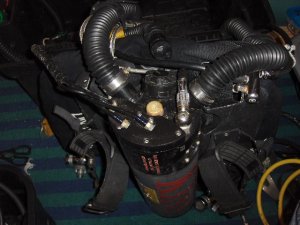 |
Remove the top plate to expose the
head |
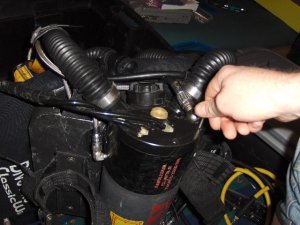 |
Slacken the six retaining bolts on the
kidney |
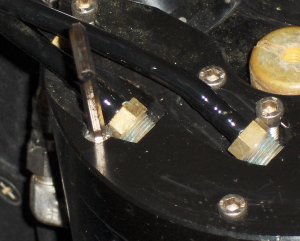 |
Be careful removing the bolts around the
cable glands. Sometimes the glands will rotate and the corners of the
brass flats on the gland can block the bolt. If this happens then you will
have to twist the gland just enough for the bolt to clear it. It is not
easy getting a spanner in there so a pair of pliers is often a better
(though rougher) option. |
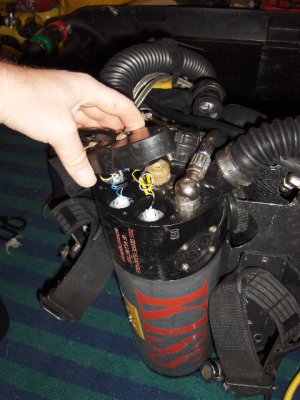 |
Once the six bolts are loose then ease the
kidney from the head. Note:
- where the three o-rings are. Each one will
either be round the turret on the underside of the kidney or in the
groove on the head
- the condition of the wires and plugs. The
sheathes can get worn and broken by being trapped when replacing the
kidney, the pins can get pulled out of the plugs, etc.
- moisture
- cleanliness. Dirt on the surface of the
head or kidney can cause poor sealing and leaks
Gently unplug all three sensors.
Whenever an o-ring which isn't frequently exposed is opened
up then it should be greased before it is refitted so it needs to be
removed and the only way to do that is remove the plugs.
Once the
kidney is freed up, remove the six bolts from their holes and put them
somewhere safe, otherwise you're guaranteed to lose one. |
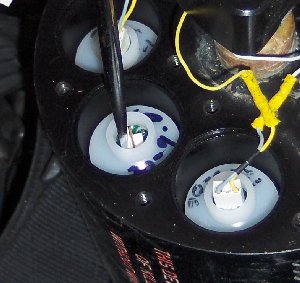 |
To
remove a sensor first of all try to unscrew it using your fingers. If it
won't move then insert a flat bladed screwdriver between the plastic guide
blade on the cell and the outer casing, not between the blade and the pins
or you may wreck the pins. Unscrew the cell anti-clockwise to
remove.
To replace the cell then just drop it into the hole and
using fingers only turn the cell until it screws in
tight. If using a new sensor then write the date it is fitted on the case
somewhere. Some new cells will come with an o-ring round the inlet on the
bottom. Discard this, the entire head is designed to be at ambient
pressure and creating a seal may damage either the head or the sensor. It
also allows the sensor to sit a bit further into the gas path which
increases reaction time.
NOTE:
a new cell takes 24hrs to wake up from being removed from the
bag. |
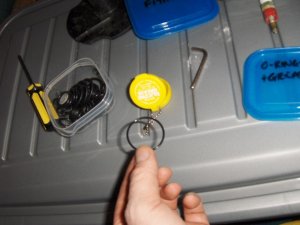 |
Grease all three o-rings and refit them to the
turrets on the kidney. Check all the o-rings for damage and
replace any that are bad. |
 |
Refit the plugs, making
sure the plug aligns with the blade on the sensor. If you're wires are a
bit long then make sure you tuck them either into the sensor housing or up
into the turret. Refit the kidney gently, feeling for trapped wires. It
should fit smoothly and solid, it should not need forced, there should be
no rocking and the kidney should be flat on the head. If not then you've
probably trapped a wire. |
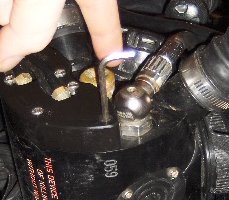 |
When the kidney is in place, keep hold of it and
switch on all the displays to check that you are getting good readings. If everything is OK
then drop the bolts into the holes. Use the allen key and tighten the bolts
with just finger force. Either grip the shaft of the key or use a finger
against the arm. As soon as you feel any resistance stop.
The o-ring makes the seal by
being in the groove, the kidney is just holding it in place, not creating
the seal. As a final check, look at the joint between the kidney and the head. There should
be no gaps at all, just a fine line. |
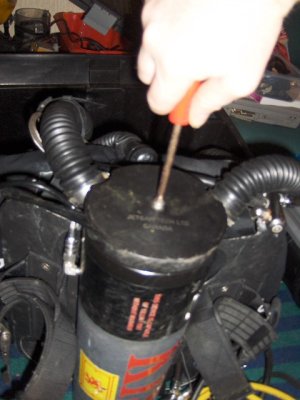 |
Refit the top plate, either fit the cylinders
or cap the regulators and do positive and negative checks. |
|
|








